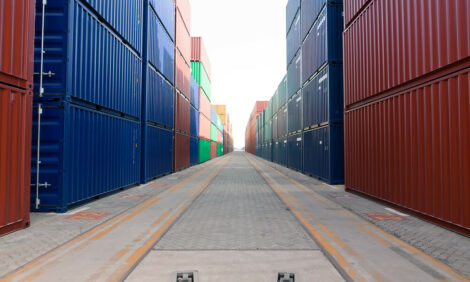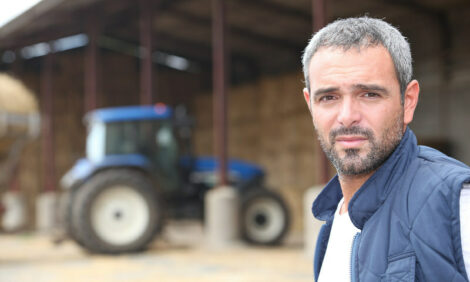



Pig Waste Converted into More Useful Products in Pilot Plant
GERMANY - In regions with intensive livestock production, manure management is a problem, but a new plant presenting research results this June is showing promise in converting manure into useful products.For a year now a pilot plant for the processing of livestock manure – constructed under the leadership of Fraunhofer IGB – has been producing mineral nitrogen and phosphate fertilisers as well as organic soil conditioners.
On June 14, 2016 the partners of the EU project BioEcoSIM will present their results and give a live demonstration of the plant.
Fraunhofer researcher Dr Jennifer Bilbao presents, in clean glass dishes, three products that can be used directly in agriculture: The first is pure ammonium sulfate, a white salt, even more finely grained than table salt (sodium chloride).
The second little dish is filled with fine, sand-coloured crystals. It is a mixture of various phosphate salts: calcium phosphate, magnesium ammonium phosphate, magnesium phosphate.
In the third little dish there are dark-brown pressed pellets reminiscent of earth – humus-forming soil conditioners.
Project manager Dr Bilbao brought the products with her from Kupferzell, where the consortium of the EU-funded project BioEcoSIM set up a pilot plant for pig manure recycling on the site of their project partner Agro Energie Hohenlohe.
Every hour the plant processes for demonstration purposes 50 kilograms of pig manure: to about 500 grams of mineral phosphate fertiliser, 500 grams of mineral nitrogen fertiliser as well as 900 grams of organic biochar.
Livestock manure: a problematic substance
Every year in Europe pigs, cattle and poultry produce around 1,800 million cubic metres of livestock manure.
According to the agricultural census of 2010, in Germany alone this means 160 million cubic metres, of which 36 million cubic metres is pig manure.
A large part of the manure is produced in the major pig farms, most of which are located in regions of Lower Saxony and Northrhine-Westphalia.
However, there is not enough arable land to spread the livestock manure at the locations where it is produced in an environmentally compatible manner.
More than half is therefore transported to regions with nutrient demand, frequently several hundred kilometres away, and this involves millions of round trips by tank truck.
Livestock manure is basically well suited for agricultural fertilisation and irrigation. Pig manure has a high water content (90 per cent).
Further components are valuable plant nutrients, mainly nitrogen and phosphorus, and indigestible feed solids such as plant fibres. However, if more livestock manure is applied to the fields than the soils can sequester and the roots of the plants can absorb, the soil becomes overfertilised.
This means, nitrogen contaminates the groundwater in the form of nitrate. As a result, in many places suppliers already mix nitrate-polluted with uncontaminated water in order to comply with the limits for drinking water supplies. Excess phosphate pollutes the water too. Unlike in the Netherlands or Belgium, overfertilisation with phosphate is not yet regulated by law in Germany.
Combined process for the treatment of livestock manure
Various steps are necessary to process livestock manure. In the course of the project the Fraunhofer researchers and their project partners have succeeded in integrating all the processes as separate modules within a single plant. This makes it possible to treat the manure directly at its place of origin and thus to extract the three products.
In a first step, manure is pretreated, so that the phosphorus dissolves completely, and separated by a coarse filtration into a solid and a liquid phase. The solid phase is then dried using a process developed at Fraunhofer IGB; this works with superheated steam in a closed system and therefore achieves a high energy efficiency.
After that, the dried organic components are converted to organic biochar at over 300°C by a pyrolysis process – in an atmosphere of superheated steam, as in the drying step. Microorganisms are completely destroyed in the process.
The liquid manure fraction contains plenty of dissolved inorganic nutrients. In a precipitation reactor first of all phosphorus is recovered, and filtered off as calcium phosphate, magnesium phosphate and magnesium ammonium phosphate.
Nitrogen is recovered in a second step. For this purpose the liquid fraction is transferred to a membrane cell. Ammonia dissolved in the water diffuses across the membrane and is recovered as crystaline ammonium sulfate.
What remains is water that now contains only traces of phosphorus and nitrogen, but which is rich in potassium and ideal for irrigation purposes.
Individually made up fertilisers
In extensive investigations and field studies the researchers have shown that the mineral fertilisers and organic soil conditioners made from livestock manure can be used directly in agriculture as readily available fertilisers and humus-forming substrates.
"We can also mix our products to obtain a nutrient composition to suit the type of plant and the soil conditions," Dr Jennifer Bilbao explained.
"This prevents any overfertilisation of the soil. Additionally, our products save on synthetic fertilisers. The production of synthetic nitrogen fertilisers requires large quantities of energy; synthetic phosphate fertilisers are obtained from raw phosphate using elaborate processes."
Finally, the mass of the dewatered and processed products makes up only about four per cent of the original volume of livestock manure. The number of round trips necessary to transport the manure would be radically reduced.
Demonstration of the pilot plant
Talks with agricultural organisations and farmers during the course of the project have indicated that there is great deal of interest in the processing and recycling of livestock manure.
The present plant has not yet been able to pay for itself out of the proceeds from the products alone, not least because of the political hurdles that exist at the moment. However, fattening farms have to pay up to 25 euros to dispose of a cubic meter of livestock manure, so this is an area with a huge savings potential.
On June 14, 2016 the project consortium will present the pilot plant in Kupferzell to interested investors, agricultural machinery manufacturers and end users in the agricultural sector.
The process steps integrated in the plant will be presented in short talks; the operation of the plant will be demonstrated live. The participants are invited to discuss the economic and ecological impact of the technology in workshops after the demonstration.








